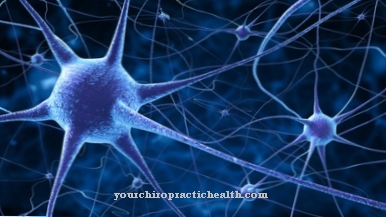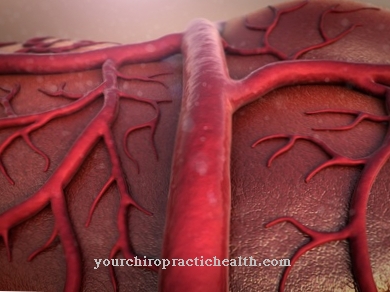Of the Anal reflex represents a foreign reflex on the external anal sphincter starting from the spinal cord segments S3 to S5. It is a characteristic reflex for examining the transmission of stimuli in the superficial perineal nerve. A lack of reflex can indicate a malfunction of the corresponding nerve pathways.
What is the anal reflex?

The anal reflex is a foreign reflex that is triggered when the skin of the anus is touched in the form of contraction of the external sphincter muscle. This also applies to the contact with the perineum and the areas of the supply area of the superficial perineal nerve. The base of the penis or the vulva is also involved in the same reflex chain. Your touch causes the bulbospongiosus muscle to contract. An older name for the anal reflex is therefore also Bulbospongiosus reflex.
Overall, the anal reflex describes the reflex reaction of the entire supply area of the spinal cord segments S3 to S5. In the case of an external reflex, the reflex-like response does not take place in the organ that received the stimulus. There is a reflex arc that transmits the stimulus through several synapses. When the skin of the anus or the entire supply area of the superficial perineal nerve is touched, the stimulus is passed on to the brain. From there, information processing is used to generate a reflex response through contraction of the external sphincter muscle.
Function & task
The anal reflex is a reaction from the supply area of the superficial perineal nerve (pudendal nerve). The pudendal nerve, also known as the pubic nerve, belongs to the lumbosacral plexus. It arises from the area of the spinal cord segments S1 to S4. It represents a subsection of the lumbar and cross plexus and is also known as the pudendal plexus.
The pudendal nerve runs caudoventrally to the pelvic floor and enters the Alcock canal through the large ischial hole (foramen ischiadicum majus). The Alcock Canal (Canalis pudendalis) is a canal in the area of the pelvic floor, which is considered a passage for various conduit structures.
The pudendal nerve divides again into several branches. These are the Nervi rectales inferiores, the Nervi perineales and the Nervus dorsalis penis or the Nervus dorsalis clitoridis. The nervi rectales inferiores (lower rectal nerves) supply the area of the anus and the external sphincter muscle. The nervi perineales in turn supply the perineum, the musculus bulbospongiosus and the musculus urethralis (striated muscle of the urethra). In addition, they also sensitively innervate the scrotum and the labia.
According to this representation, the anal reflex is a partial reflex of a larger complex, since the pudendal nerve with its three branches supplies a larger area in the anal and genital region.
Reflexes are natural responses to stimuli. The anal reflex (contraction of the external sphincter) is triggered during sexual acts by touching the erogenous zones in order to avoid defecation. The same goes for urinary retention during intercourse.
External reflexes, however, have the property of being able to be influenced at will. In this way, the reflex can be strengthened or weakened. The triggering of the reflex during the examination is intended to check the function of the pudendal nerve.
Illnesses & ailments
If the anal reflex is absent, this indicates neurological disorders. Functional disorders or injuries to the inferior rectal nerves can lead to incontinentia alvi, among other things. Damage to the perineal nerves leads to paralysis of the urethral muscle. As a result, urinary incontinence occurs.
Incontinentia alvi is faecal incontinence. The anal sphincter no longer works properly. The causes are manifold. To trigger fecal incontinence, several factors usually have to come together. The failure of only one control mechanism is not sufficient for defecation, since compensation mechanisms are triggered in these cases.
The continence organ (occlusion device of the anus) is responsible for proper defecation. This organ also includes the internal and external sphincter muscles. However, the external sphincter can be consciously contracted, even when there is a strong need to defecate. The contents of the intestine are pressed back into the rectum.
The failure of the anal reflex does not have to lead to fecal incontinence, but it is a serious indication of a possibly underlying disease that suppresses the transmission of stimuli from the spinal cord to the pelvic area.
In addition to direct disorders of the sphincter muscle, there are several causes of fecal incontinence associated with the anal reflex. These include disorders of impulse processing, interruption of the transmission of impulses, sensory disorders and psychological disorders.
Impulse processing is disrupted by diseases such as Alzheimer's disease, stroke, multiple sclerosis or brain tumors. With these diseases it can happen that the impulses arriving in the brain are no longer processed and the anal reflex does not occur. An interruption of the impulse transmission occurs, among other things, with paraplegia, multiple sclerosis or a neural tube malformation (spina bifida).
In the case of sensory disturbances, sensitive perception is prevented, for example, by the intestinal mucosa or hemorrhoids being pushed forward, so that no signal at all is sent for the anal reflex. The anal reflex can also fail with mental disorders and psychoses.
In urinary incontinence, the cause can also be found in a reflex disorder. Paraplegia, multiple sclerosis or other diseases play a role in the lack of reflex contraction of the urethral muscle. Both fecal incontinence and urinary incontinence can therefore be caused by a reflex disorder of the pudendal nerve.

























.jpg)

.jpg)
